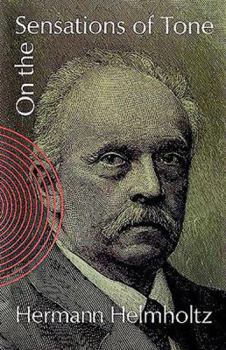On the Sensations of Tone
Select Format
Select Condition 
Book Overview
On the Sensations of Tone is one of the world's greatest scientific classics. It bridges the gap between the natural sciences and music theory and, nearly a century after its first publication, it is... This description may be from another edition of this product.
Format:Paperback
Language:English
ISBN:0486607534
ISBN13:9780486607535
Release Date:June 1954
Publisher:Dover Publications
Length:608 Pages
Weight:1.80 lbs.
Dimensions:1.1" x 6.1" x 9.2"
Customer Reviews
5 ratings
Thorough, leisurely study of the principles of musical harmony and scales
Published by Thriftbooks.com User , 18 years ago
Part 1 discusses how tones may be perceived as built up by the base tone and the "harmonic upper partial tones". These upper partial tones are what distinguishes different instruments and they determine the "quality of the tone"; e.g. "if only the unevenly numbered partials are present ... the quality of the tone is hollow, and, when a large number of such upper partials are present, nasal", etc. (p. 119). Helmholtz's model of the ear has it that there is a spectrum of hairs in the ear, each with its own mode of vibration. When we hear a tone it is decomposed into its partials through "sympathetic resonance" of the corresponding hairs, and it is this information--i.e. essentially Fourier coefficients--that is sent to the brain. Part 2 discusses the theory of consonance. Again, the Fourier analysis point of view is the key. The consonance or dissonance of two tones is determined by the interaction of the partials of the tones, giving mathematical precision to the idea that "two consonant tones flow on quietly side by side in an undisturbed stream; dissonant tones cut one another up into separate pulses of tone" (p. 226). Thus one can claim that "ultimately, then, the reason of the rational numerical relations of Pythagoras is to be found in the theorem of Fourier, and in one sense this theorem may be considered as the prime source of the theory of harmony" and so "the enigma which, about 2500 years ago, Pythagoras proposed to science ... 'Why is consonance determined by the ratios of small whole numbers?' has been solved by the discovery that the ear resolves all complex sounds into pendular oscillations ... and that it regards as harmonious only such excitement of the nerves as continue without disturbance" (p. 229). Part 3 studies scales; quoting from the conclusion: "the construction of scales ... is a product of artistic invention, and by no means furnished by the natural formation or the natural function of our ear, as it has been hitherto most generally asserted. Of course the laws of the natural function of our ear play a great and influential part in this result; these laws are, as it were, the building stones with which the edifice of our musical system has been erected, and the necessity of accurately understanding the nature of these materials in order to understand the construction of the edifice itself, has been clearly shewn by the course of our investigations upon this very subject. But just as people with differently directed tastes can erect extremely different kinds of buildings with the same stones, so also the history of music shews us that the same properties of the human ear could serve as the foundation of very different musical systems." (p. 366).
Good, but very old; read Jeans instead (or something modern)
Published by Thriftbooks.com User , 18 years ago
This book is of historical interest only, I think; it's very well written, but a lot of its content is mind bogglingly outdated, ancient. If you need a readable quick intro into sound, read Jeans's book (the first part of it is updated Helmholtz). Then, if you still need to (as in "know specifically what I'm after and it can be found only in Helmholtz"), you can pick this book; but otherwise, resorting to modern literature will be a much better investment of your time.
I concur.
Published by Thriftbooks.com User , 23 years ago
This is worthwhile for the reasons already cited (so I need not rehearse them), but it is important to recognize that much of it has been superceded or disproved. I hope those prospective purchasers who have found their way here are aware of Juan Roederer's THE PHYSICS AND PSYCHOPHISICS OF MUSIC--very much recommended!
An undisputed classic in the science of hearing and music
Published by Thriftbooks.com User , 25 years ago
Helmholtz's Sensations of Tone became an almost instant classic in the study of hearing when it was published in 1863. It combined the physics, physiology and psychological aspects of hearing in an attempt to explain the origins of musical harmony and dissonance. Though not easy reading, it is accessible to the non-specialist. However it also provides an important historical resource for the specialist and helps one to understand the origins of so much of contemporary hearing research. Indeed, in many ways Helmholtz reads more like a contemporary than a long-past founding father. The appendices provided by the translator are helpful as well. Finally, the inexpensive paperback edition from Dover makes this book an excellent bargain.
historical reference
Published by Thriftbooks.com User , 25 years ago
This is the most historically significant treatment of musical acoustics easily available. The serious musician should keep a copy for reference, but I don't recommend that the novice start here. Some fascinating musical ramifications of elementary acoustics are to be found in PENTATONIC SCALES FOR THE JAZZ-ROCK KEYBOARDIST by Jeff Burns.





